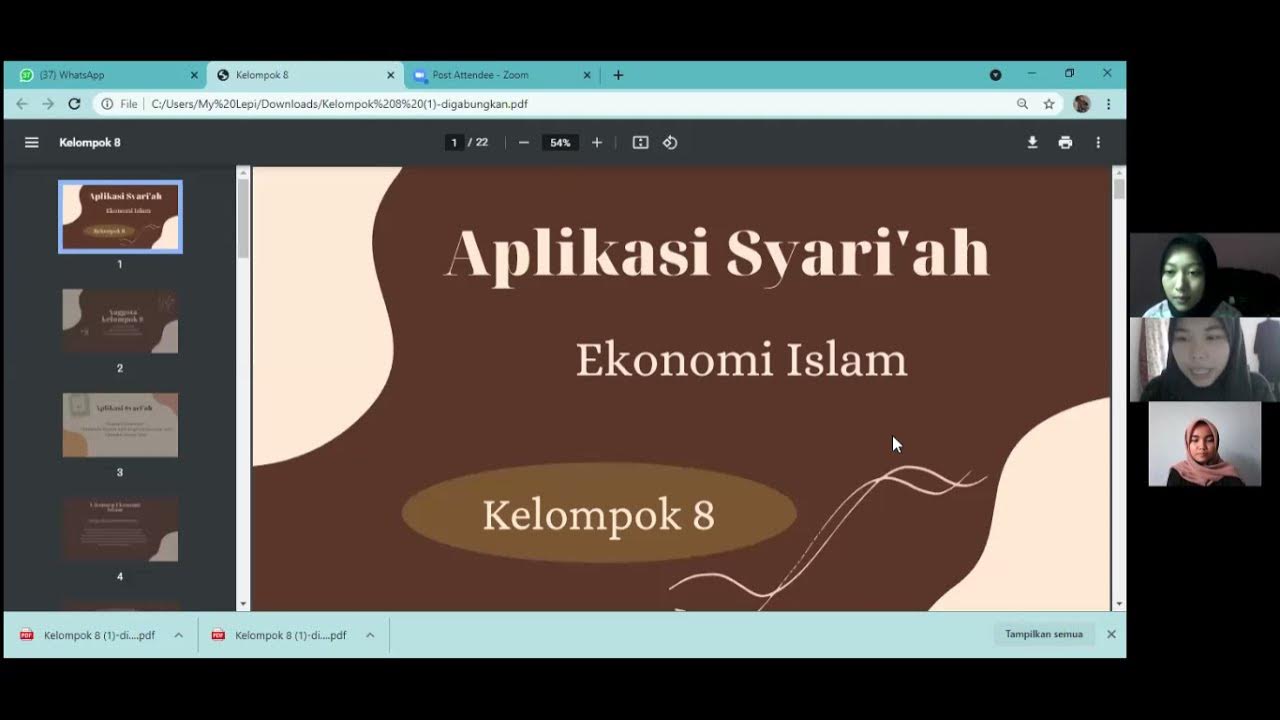Tugas Produksi 2024 D Ekonomi Mikro Islam
Summary
TLDRThe transcript explores the key principles of Islamic microeconomics, focusing on the ethical and sustainable production practices that distinguish it from conventional economics. It highlights the objectives of promoting both material and spiritual well-being while balancing individual and societal needs. The discussion also covers resource exploration, stressing the importance of justice, ecological sustainability, and responsible management through contracts like Muzara'ah (partnership), Ijarah (lease), and Musyarakah (joint venture). Youth are encouraged to evaluate which contract is most suitable for modern resource exploration, ensuring fairness and social welfare in line with Islamic principles.
Takeaways
- 😀 Islamic microeconomics focuses on both material and spiritual welfare for individuals and communities.
- 😀 The primary goal of production in Islamic economics is to create societal benefits (kemaslahatan).
- 😀 Islamic economics seeks harmony between individual and societal needs, aligning with the teachings of Islam.
- 😀 In Islamic economics, natural resources are considered public goods, managed by the state on behalf of society.
- 😀 Resource exploitation should prioritize collective welfare and avoid excessive private gain or exploitation.
- 😀 Environmental sustainability is a core principle, prohibiting environmental harm and promoting ecological balance.
- 😀 The concept of *ihya' al-mawat* encourages the productive use of land and resources to benefit society, such as transforming barren land into productive areas.
- 😀 *Muzaraah* is a partnership where landowners provide land for cultivation in exchange for a share of the profits, promoting fairness and collaboration.
- 😀 *Ijarah* is the leasing of land under Islamic law, governed by fairness, transparency, and the mutual benefit of both parties involved.
- 😀 *Musyarakah* is a profit-sharing partnership where risks and rewards are equitably shared, ensuring fairness in resource management and economic transactions.
Q & A
What are the main differences between Islamic microeconomics and conventional economics in terms of production goals?
-In Islamic microeconomics, the production goals emphasize both material and spiritual welfare, focusing on the well-being of society and individuals in accordance with Islamic teachings, whereas conventional economics typically prioritizes material wealth and economic efficiency.
What does the concept of 'kemaslahatan' mean in Islamic economics?
-'Kemaslahatan' refers to the welfare or benefit of society, ensuring that the outcomes of economic activities contribute to the greater good, including both material and spiritual well-being.
How does Islamic microeconomics view the exploration of natural resources?
-Islamic microeconomics advocates for the exploration of natural resources in a way that is balanced, ethical, and sustainable, ensuring that the exploitation of resources is done for the benefit of society and does not harm the environment or lead to excessive exploitation.
What is the Islamic principle of 'khalifah' and how does it apply to resource management?
-The principle of 'khalifah' refers to the responsibility of humans as stewards of the earth. In the context of resource management, this means humans are entrusted with the care and sustainable use of natural resources, ensuring fairness, justice, and environmental preservation.
What role does justice play in the management of natural resources in Islamic microeconomics?
-Justice plays a key role by ensuring that natural resources are managed equitably, without exploitation or harm to any party. The goal is to ensure the welfare of all members of society and prevent concentration of wealth or resources in the hands of a few.
How is the concept of 'amanah' (trust) applied to the ownership of natural resources in Islam?
-'Amanah' refers to the concept of trust, meaning that natural resources are not owned by individuals but are viewed as public goods managed on behalf of society. The state is responsible for managing these resources for the collective benefit, ensuring they are used wisely and responsibly.
What is the significance of ecological balance in Islamic microeconomics?
-Ecological balance is crucial in Islamic microeconomics, as it stresses the importance of not damaging the environment. Resource exploitation must be aligned with environmental sustainability, avoiding activities that lead to harm, such as pollution or destruction of ecosystems.
What is the concept of 'ihyaul mawat' and how does it relate to economic activity?
-'Ihyaul mawat' refers to the revitalization of barren land, encouraging productive use of resources for the benefit of society. In economic terms, it suggests developing unused or underutilized resources, such as transforming barren land into productive agricultural land or supporting local businesses.
What are the different contractual schemes mentioned in the transcript, and how do they apply to resource exploration?
-The transcript mentions three contractual schemes: 'Ijarah' (fixed lease), 'Musyarakah' (partnership or profit-sharing), and a contract based on social and environmental responsibility. These schemes ensure fairness, transparency, and the protection of the environment in resource exploration.
How should contracts in Islamic economics be structured to ensure justice and avoid exploitation?
-Contracts should be structured to promote fairness, transparency, and equitable distribution of risks and rewards. For example, a partnership (musyarakah) ensures that profits and losses are shared fairly, and lease agreements (ijarah) should specify clear terms that avoid unjust exploitation or harm.
Outlines

This section is available to paid users only. Please upgrade to access this part.
Upgrade NowMindmap

This section is available to paid users only. Please upgrade to access this part.
Upgrade NowKeywords

This section is available to paid users only. Please upgrade to access this part.
Upgrade NowHighlights

This section is available to paid users only. Please upgrade to access this part.
Upgrade NowTranscripts

This section is available to paid users only. Please upgrade to access this part.
Upgrade Now5.0 / 5 (0 votes)





